Written by Pamela UGAZ, Economic Affairs Officer, Article No. 30 [UNCTAD Transport and Trade Facilitation Newsletter N°81 - First Quarter 2019]
The 22 February 2019 not only marks the second anniversary of the WTO Trade Facilitation Agreement, but it is also a critical implementation date. But an initial step – notification on implementation and assistance – remains a pending goal for almost half of WTO members.
The Agreement on Trade Facilitation (TFA) of the World Trade Organization (WTO), entered into force on 22 February 2017, when two-thirds of the 164 WTO members ratified it. The TFA – the first multilateral pact WTO members had agreed since it was founded on 1 January 1995 – represents a significant milestone for the global trading system.
The TFA aims to expedite trade procedures, including the movement, release, and clearance of goods. Its full implementation could boost global trade by $1 trillion per year, cutting trade costs down by 14.3% for low-income countries and more than 13% for upper-middle-income countries.
Estimates show that developing and Least Developed Countries (LDCs), mainly African countries, could see the most significant reduction in trade costs.
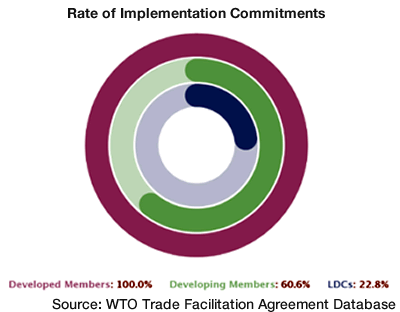
Notwithstanding these promising estimations, the WTO calculates the average rate of implementation commitments at 61.3%, while the average for LDCs only stands at 22%. However, the rate of implementation commitment yet to be decided stands at 18.3%.
The second anniversary of the agreement is an excellent time to review the level of ratification, implementation notifications, and transparency obligations of the TFA.
Implementation notifications:
Developing and least-developed WTO members can self-determine the time and the means required to implement each of the substantive provisions (Article 1-12), classifying and notifying them (see timetable ) under the following categories:
-
Category A: provisions that the developing WTO members should have implemented by 22 February 2017, the date of entry into force (Least Developed Countries needed to implement them by 22 February 2018).
-
Category B: provisions that a developing or an LDC member should have designated for implementation after a transitional period of time counting from 22 February 2017.
-
Category C: provisions that a developing or LDC member should have appointed for implementation after a transitional period and the provision of assistance and support for capacity.
1. Ratification
In the two years since taking effect, 141 out of 164 countries have ratified the agreement, accounting for 86% of WTO membership (applying the TFA on a Most-Favoured-Nations basis). 12 out of the remaining 22 countries are LDCs., while the other ten are developing countries. Indeed, nine countries have neither ratified the TFA, nor have they notified Category A, B, and C commitments. This denotes that the level of development may have a direct impact either in the complexity of legal systems and or the capacity of countries to assess what they need to do, prompting a call to donors and development partners to assist in legal processes.
What are the consequences of ratifying the TFA in the following months?
Under Article 24.4, developing countries shall implement their category B and C commitments counting the relevant periods from 22 February 2017, the date of entry into force. In other words, developing countries ratifying the TFA, for example, in August 2019 must notify their category A, B and C designations plus the definitive implementation dates and information on the required Technical Assistance and Capacity Building (TACB). These developing countries will not enjoy the possibility of submitting first indicative dates to convert them, after a year, into definitive dates because the deadlines have already passed.
Under the same example, LDCs will need to provide, at the moment of ratification, the due notifications of the previous years (category A, B and C designations, indicative dates for category B and information on TACB). Besides, the timeframes to comply with the next notifications will be shortened.
2. Implementation Notifications
Section II of the agreement sets forth ground-breaking provisions on special and differential treatment, linking implementation by developing countries and LDCs to the acquisition of the capacity to implement the agreement for the first time in WTO history (see box).
Although developing countries had to notify the three categories above two years ago (22 February 2017) and LDCs had to do the same last year (22 February 2018), WTO data shows otherwise [See timetable].
Only 85 out of the 125 developing and least-developed WTO members notified the three categories (64 developing countries and 21 LDCs). Eleven members (three developing countries and eight LDCs) have not notified any designation.
Category A designations have the highest rate of notifications, 114 countries in total; followed by 74 and 63 countries that have notified their categories B and C designations respectively (Figure 1). It is noteworthy that nine developing countries have announced all measures under Category A, ruling out the possibility of designating any category B or C commitments. This group is composed of countries with high customs modernization performance such as Singapore, Hong Kong-China, and the Republic of Korea, among others.
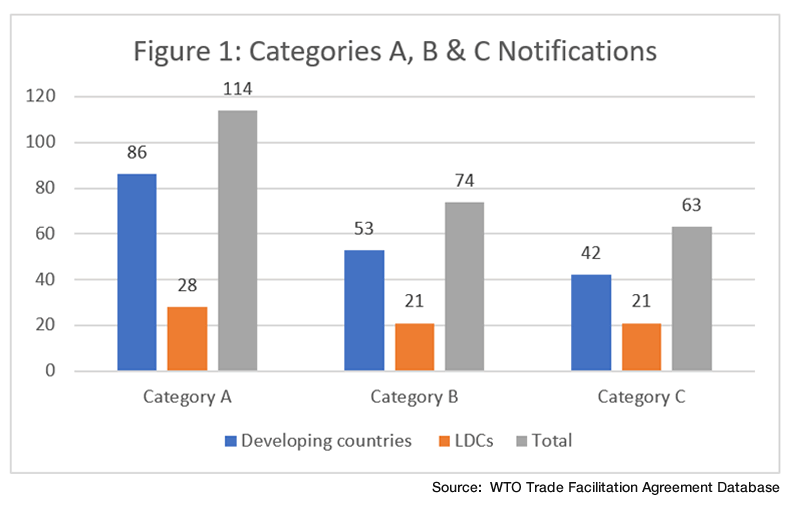
The TFA requested developing countries to notify their Category B designations and indicative dates by 22 February 2017, while the definitive date should have been notified a year later. Nonetheless, only 43 out of 89 developing WTO members have fully complied with this requirement.[1]
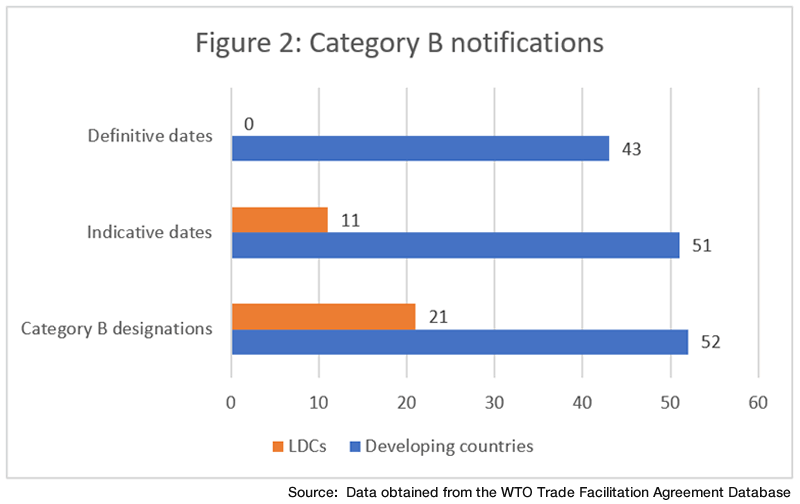
As to LDCs, only 21 out of 36 least-developed WTO members have submitted Category B designations (Figure 2). Eleven out of the 21 LDCs have presented their indicative dates, although this notification is not mandatory yet.
Developing countries should have notified their Category C designations along with indicative dates by 22 February 2017; however, roughly half of them have complied with this requirement (Figure 3). Just six months before the deadline, only 14 developing countries have notified definitive dates for Category C, raising a red flag. Regarding LDCs, 15 countries owe their notifications despite the deadline having expired a year ago.
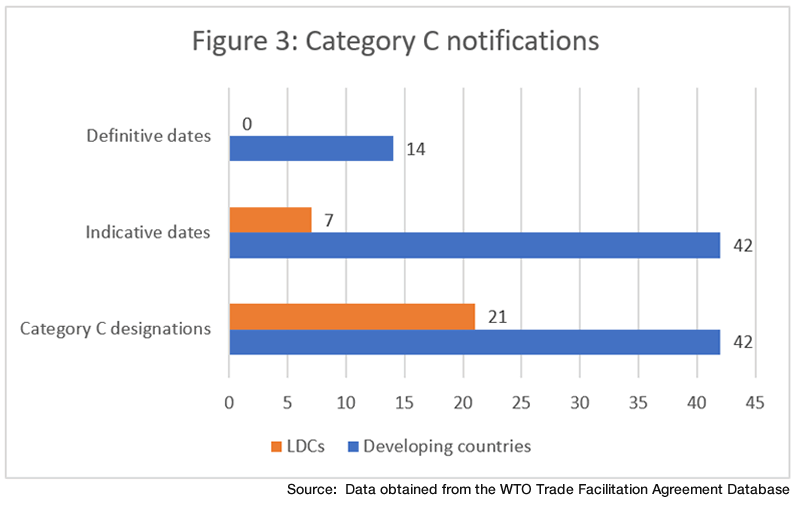
On the positive side, seven LDCs have already notified their indicative dates, although the deadline still expires in two years (22 February 2021), giving a clear signal to donors about their commitment to implementing the agreement.
3. Assistance and capacity building notification
Developing countries had to make a notification on the technical assistance required to implement their Category C designations by 22 February 2017. Two years have elapsed, and only 42 developing countries have fully submitted this information (46% of the total number of developing WTO members). LDCs are not performing any better. The deadline to submit information on the required TACB is today – 22 February 2019 – and only three LDCs (9% of all least-developed WTO members) have provided the type of technical assistance required.[2]
As to the type of TACB requested, human resources and training needs are at the top of the list accounting for 38.6% of the requests, followed by assistance in enabling legal frameworks (34.7%) and acquisition of information and communication technologies (31%). Nevertheless, 39.6% of requests does not specify at all the type of TACB requested, suggesting challenges in the process of identification of TACB needs.
Moreover, both developing countries and LDCs had to submit to the WTO information on contact points for coordinating such TACB (Article 22.3). As of 22 February 2019, only five developing countries have complied with the obligation. This low compliance makes it difficult for donors and development partners to coordinate the assistance and rely on the readiness of these countries to undertake ambitious trade facilitation projects.
Developed WTO members have committed to submit information on the disbursed and committed assistance and support for capacity building to the WTO (Article 22.1) as well as contact points and information on the process and mechanism for requesting assistance (Article 22.2).

As of 22 February 2019, 15 notifications[3] have been submitted providing information on their technical assistance programs, while only eight[4] out of these 15 developed WTO Members have notified their mechanism for requesting TACB. These figures show that developed countries must put extra efforts into complying with the notification to provide a sign of their support to developing and least-developed WTO members.
4. Transparency notifications
The TFA sets out a set of transparency obligations regarding substantive provisions of the agreement related to i) online descriptions of trade procedures; ii) contact points to respond to inquiries; iii) the operation of single windows; iv) the use of customs brokers; and v) the contact points for exchange of customs information.
Figure 4 summarizes the notification on the items listed above, received as of 20 February 2019, from developed, developing and least-developed WTO members.
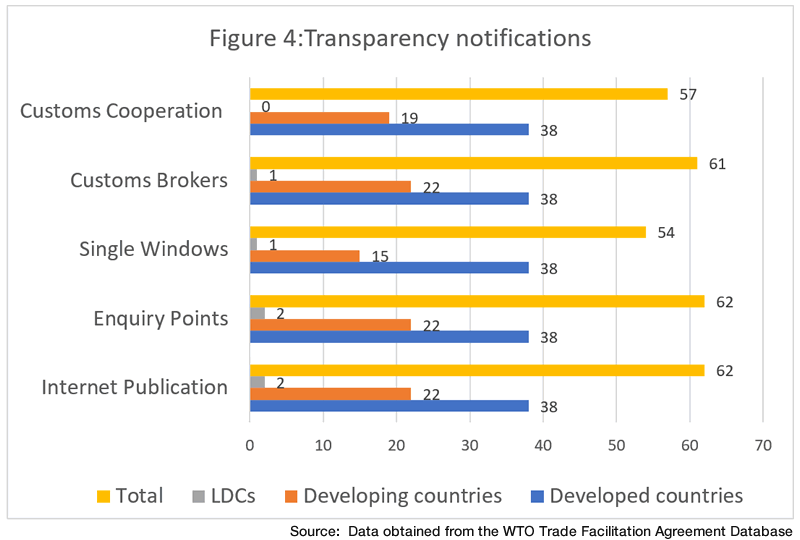
It is noteworthy to mention that Lao People's Democratic Republic and Malawi are the only LDCs that have made notifications on the operation of their Single Window systems (where traders submit regulatory documents at a single location).
5. National Trade Facilitation Committees
Operational committees allow WTO members not only to comply with Article 23.2. that requests the establishment of such bodies, but they are also instruments to fulfill Article 2.2 on consultations between border agencies and the private sector. On average, 40% of NTFC members represent businesses, making them the perfect platform for regular public-private consultation.
Even though the TFA does not request for the notification of NTFCs, the level of public-private coordination can be measured by looking at the rate of implementation of the TFA Article 2.2 on consultations.
The WTO sets the rate of implementation commitment at 46.4%. Developing countries perform about three-times better (57.3%) than LDCs (19%) in holding regular public-private consultations.[5] That said, these numbers are still concerning and show the remaining need for support to developing countries and LDCs to set up and strengthen public-private partnerships.
6. Grace period from the Dispute Settlement Mechanism
Going further in the special and differential treatment provisions, the TFA grants developing countries and LDCs a grace period in which both groups of countries are exempted from the application of the Dispute Settlement Understanding (Article 20). With the level of development taken into account, the agreement sets out shorter periods for developing countries and more extended periods and a broader scope for LDCs.
The grace period provided to developing countries for Category A designation expires today, 22 February 2019.
Developing countries could be brought to the WTO Dispute Settlement Mechanism henceforth for a dispute concerning any provision that such developing countries have designated in Category A.
LDCs can still enjoy this exemption for a longer time. Indeed, LDCs benefit from a six-year grace period for Category A designations after entry into force, namely until 22 February 2023; while the grace period is eight years for Category B and C designations counted after the implementation of such provisions. However, those countries should, upon request, provide adequate opportunity for consultation during the grace period for discussing issues relating to the implementation. As of today, the TFA has been cited once in a consultation requested by Ukraine against the Russian Federation.
Recommendations to keep in mind
After this reality check, developing countries and LDCs seeking to reap the benefits from the agreement fully might consider the following recommendations:
-
Ratify – the sooner, the better: Developing countries that ratify the agreement in coming months (hopefully not years) have already missed some critical due dates, which will prevent them from using the special and differential treatment provisions of the TFA to their maximum.
-
Notify, notify, notify: Developing countries and LDCs willing to seize the special and differential treatment provisions of the TFA must comply with the implementation notification requirements set out in the agreement. These notifications are part of the deal. Developing countries cannot expect to reap the benefits from these flexibilities if they do not comply with their part of the deal.
-
Look at your calendar: By the same token, once the missing countries have updated their notifications, they need to follow up on future announcements. New notifications days are coming soon (see timeline).
-
Kick-off your National Trade Facilitation Committees by inviting in traders: Public-private partnerships are the cornerstones needed for implementation of the WTO TFA to succeed. Who knows better the bottlenecks in trade procedures than traders? Therefore, it is important to invite them to participate in the committees. Moreover, NTFCs should join synergies with other national committees – such as Sanitary and Phytosanitary regulatory committees or Technical Barriers to Trade Committees and foster regional platforms.
-
Watch your behavior: developing countries can now be brought before the Dispute Settlement Mechanism. So they need to keep track in the compliance of their Category A designations.
-
Conduct a legal inventory: Once a country has decided on its Category C designations, it should start thinking about building a legal enabling framework for the implementation of these measures. The first step is to conduct a thorough legal gap analysis, aimed at identifying where amendment or new regulations are needed. This is the baseline for any trade facilitation legal.
[1] Note that ten developing WTO members have not ratified the TFA yet.
[2] Note that 12 least developed WTO Members have not notified the Agreement yet.
[3] The submission of information on the TACB provided by the European Union is among these 15 notifications.
[4] These eight notifications include one sent by the European Union.
[5] These percentages represent the share of notification of Category A designations for Article 2.2. Note that developing countries and LDCs, although complying, might have made use of their right to delay implementation by notifying Article 2.2. under categories B or C.



